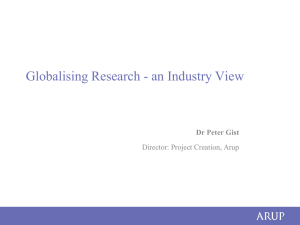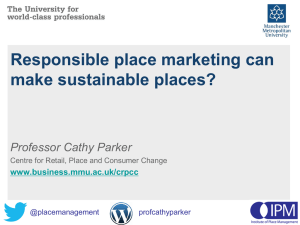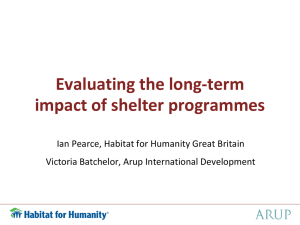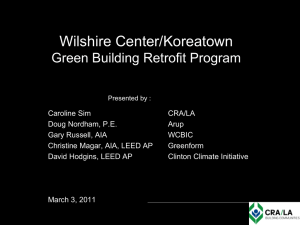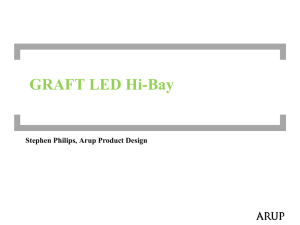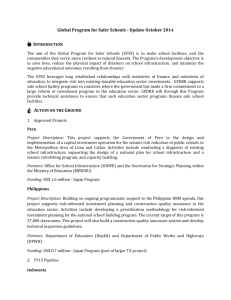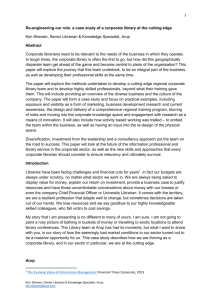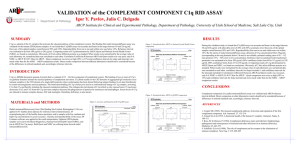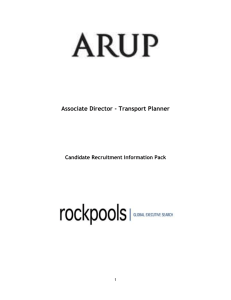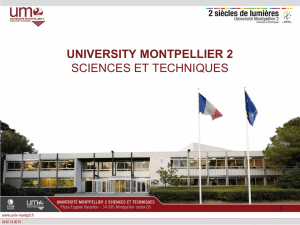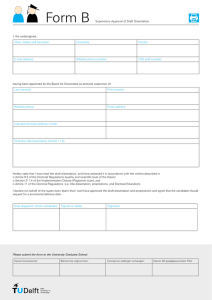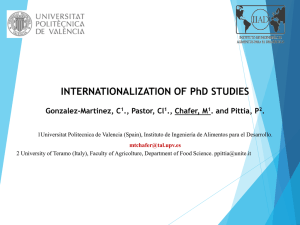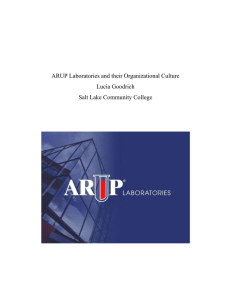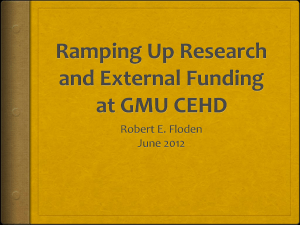How modern universities and industries can work together
advertisement
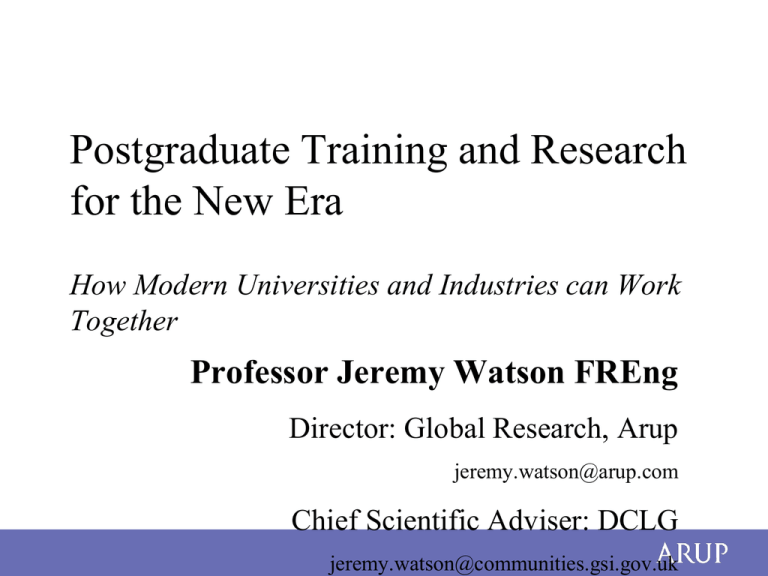
Postgraduate Training and Research for the New Era How Modern Universities and Industries can Work Together Professor Jeremy Watson FREng Director: Global Research, Arup jeremy.watson@arup.com Chief Scientific Adviser: DCLG jeremy.watson@communities.gsi.gov.uk Arup A trust, not a public company - 10,000 employees worldwide - 90 offices - Multidisciplinary Driven by belief in benefiting society and delivering the best quality of work Investing to develop knowledge and capability Innovation a key differentiator, togther with Design excellence and quality Engineering • • • • Dedicated Innovation executive Close linkage with Foresight and Research groups Flexible interventions: SPVs, licensing, market testing and introduction Example: Investment in contactless recharging of electric vehicles Arup – Projects Major projects include: - Sydney Opera house (Australia) Pompidou Centre (France) Stansted Airport (UK) Channel Tunnel Rail Link (UK) Beijing Olympics – Water cube and Bird’s Nest stadium Cross Rail Integrated Research, Design and Engineering is a key business differentiator Research context in Arup • Research seen as essential to maintain and grow market position – and identify incremental and step-out opportunities • Research is typically ‘applied’ and anticipatory of business need: time scale – ‘now’ to three years+ • Emphasis on innovation: ‘Concept to Commercialisation’ • Research ‘pull’ – from Business leaders and ‘push’ – from Design and Technology networks and academic partners • Research fund to encourage internal and external investment • Driven by strategic roadmap Arup Research capabilities 3-D Modelling Acoustic s Advanced Analysis Air Quality Archaeology / Heritage Asset Management Audio Visual Aviation Building Physics Business Performance Business Systems Communications Contaminated Land Controls Corporate Responsibility Cost Demand Analysis Design Research Development Planning Dynamic Behaviour (structures) Ecology Economics Education Electrical Services Energy Environment Facades Flood management Fluids Geology Geotechnics Healthcare Highw ays Human Behavioural Dynamics Industrial Consulting Inspection Repair Refurb Investment appraisal IT Know ledge Management Landscape Lighting Logistics Maritime Materials Mechanical Services Moving Structures People Movements Pharmaceuticals Planning Regulation Product Design Project Management Public Health Railw ays Safety Tunnelling Universal Access Urban Design Vehicle Design Venues Vertic al Transportation Waste Water Workplace Performance Arup Research – Global Deliverables Research Offering Components • Corporate research roadmaps 1. Strategy • Regional and group strategy facilitation • Grow and develop the research network 2. Network • Internal engagement in multidisciplinary research • Engagement with key external partners • Set up and management of research consortiums 3. Funding • Links to research funding bodies 4. Building capability • Doctoral training Delivering the Research Strategy Influencing research agendas • Facilitating and supporting the delivery of regional research strategies • Implementing roadmap-based funding mechanisms • Sharing priorities with partners and funding agencies Research Strategy Regional Research Champions Global strategy team Regional Champions act as representatives and liaison points for corporate Research. They are responsible for supporting the development and executing the Regional Research Strategy Relationships with National Funding Agencies Proactive mission to promote mutually-beneficial relationships - Thought-leadership and ‘agenda calibration’ - Unbiased sectoral representation - Roadmap-sharing to assist national research agendas Awareness of and response to Calls Consortium formation Strategic Partnerships - EPSRC allowing definition of Programmes under joint funding Research Funding at Arup In house research - R&D calls for proposals for Global and regional projects £600k - Project Plus £50k External collaborative: regional and global - External Collaborative Research projects £600k Global, £130k Americas - Pays Arup staff time and expenses for collaborations - Leverage between x1.5 and x4 Manage ~£2.5m Arup’s Knowledge Supply Chain Arup’s approach – a Knowledge Supply Chain Foresight - Internal using roadmapping - External using focus groups Product Service Process Research strategy development - Consultation with business units and clients Research execution - Collaboration with universities and research councils Validation and deployment Capability development - In-house university offering EngDs with UCL - 55 (internal + external) doctoral students world-wide Innovation Now, New, Next • Emerging trends – Drivers of Change • Thought leadership • Delivering the agenda Concept • Needs interpretation • Knowledge generation • Delivering IP • Community • Operational excellence • Delivery to projects ‘New’ Foresight Research ‘Now’ Commercialisation ‘Next’ Skills Networks Time Managing Ideas Food production BIPVIdea creation & Odersund triage Glass roofs Low cost PV Balu Airplank Geotechnichs and Google Earth SparACE BAU Closed CAS-wind turbines NEW Truss floor Habitat mapping DefinIT Biodiversity Green Roofs Twisting towers Cold sintering of carbonate True colour terrestrial laser scanning Realdania Mortar-less brick wall Solar Chimney Whiplash protection Commercialisation TekDek SparACE Open projects Pufferfish Legal processes Green date centres Rainwater harvesting Bullet trajectory Mail manager support for blackberry Hydrofluids Invarion Inflatable roof Origin of the idea External Internal Joint Inhaler mouth piece design SEED NURSERY DEVELOPMENT ESTABLISHED Arup University Arup has always provided a learning culture In 2007, we added a formal programme of staff development Doctoral modules Accredited EngD qualification 4-year, on-the-job Driven by business need Masters modules Intensive 10 day specialist training Provided by HEI partners Professional modules Distance and face-to-face CPD Provided by regional skills networks Doctoral study • Arup University Doctoral Programme • Agreed guidelines permit ‘study on the job’ – 40 days per year study • Doctoral awards accredited by UCL under terms of a strategic MoU Delivery partnerships with Columbia University, NY and HKUST • • Recruitment of first cohort of Research Engineers: >50 applications • • Establishment of Doctoral College Conference November 2011 Doctoral College “The Doctoral College was set up to create a community of Arup research students, where they can share knowledge, experiences and foster links between internal Arup experts and external doctoral students, their academic supervisors and host universities.” Doctoral College established Spring 2011 55 members and growing Includes all students undertaking PhD study either part funded or supported by Arup (e.g.EngD’s, CASE Award, Arup University DM modules, part time study) HEI Collaboration supported by Arup Lecturing and supervision Studentships • Internships • Sponsored first degree students • Masters (incl. Arup branded courses) • Doctorates, Eng D Research collaboration • Co-sponsorship of government funded research • Use of specialised facilities at universities: cooperation/fee for service • Contract research Strategic engagement • Endowed chairs at departments • Staff education-Arup University • Membership of university advisory groups Example: Collaboration with UCL Multi-threaded, ‘natural partnership’ Thames Gateway Institute for Sustainability - Research partners - IfS chair EPSRC Networks - Eco-cities with China Arup’s in-house ‘university’ - Doctoral registration, accreditation and research training IDC/CDT involvement: Sustainability and Resilience, Energy Advisory Boards: Enterprise, Sustainable Cities Reciprocal visiting staff and faculty Doctoral studentships (CASE, EngD, etc.) What are the challenges of Industry-HEI collaboration? • IP & contracts • Information sharing – Who are the experts? • Gap between proven technology (TRL 3) and implementation (TRL 6-7) • Dissemination – ‘Continuous transfer’ • Measuring the impact What are the benefits? • Open innovation • Creating and demonstrating Impact – business and academic • Partnering for adventurous research - Higher risk research appropriate for HEIs • Leveraging research funds - Co-funding with Research Councils - Private/public research consortia (e.g. E2B PPP) • Allowing client dialogue to continue in downturn - Interests beyond immediate business - Identifying future opportunities and preparing through research • Respond to strategic priorities • Collaboration vs. spin out – long term investment Innovation drives Collaboration What is Innovation? It’s not just about invention or creativity (but creativity’s pretty important) Concept to Commercialisation? (TSB’s new theme) Idea to Implementation? Schumpeter: ‘Creative destruction’ – Disruptive technologies Displaces and replaces – products, processes Also augments, makes more effective Associated with entrepreneurial thinking Creating jobs which did not previously exist, and solving problems that people assumed were part of the natural order of things (Economist, Feb 24 2011) Types of Innovation Push - Technology creates a market Long gestation, success = high payoff Pull - Existing market drives development Rapid deployment, standards help Platform innovation - Enhancement of market Concurrent and continuous - Collaboration across supply chains Facilitated by industry associations Triggering and nourishing innovation Thought-styles - Analogies, cross-discipline transfers, e.g. Biomimetics - Systems thinking and multi-disciplinarity - Curiosity-driven research Real needs - Economic growth, carbon neutrality Funding environment (UK) - Flat CSR, Technology Strategy Board active and effective Connectivity and partnerships - Co-creation and open-source approaches Some current effectors in innovation VTT thoughts • Blurring of industrial boundaries • Co-creation with the customer and with users • Social media changing the life style • New generations have different values and ways to make decisions • Shifting center of gravity of global business is changing the rules • Outsourcing / Crowdsourcing of R&D&I Government interventions can help Research Councils (7) - £2.5bn investment in university research per annum - Company participation through sponsorship, research students, etc. Technology Strategy Board - Technology transfer and deployment - Innovation Platforms 50% support - Collaborative R&D - Knowledge Transfer Networks (KTNs) - Knowledge Transfer Partnerships (KTPs): 66% / 70% employment costs - SBRI – Strategic procurement: 100% funding Innovation - Inhibitors and Drivers Cost - E.g. Pharma - £1bn, 10 years, 1 in 20 success rate Getting less favourable IP - Academic approaches can be an impediment, only 10% of revenue at MIT Risk mitigation through: - Modelling - Open innovation - Sharing risk e.g. with trials patients in Pharma New ideas vs. Incremental thinking – c.f. Academic drivers/risks Examples of Arup Collaborative Research Emerging Research Topics for Collaboration Carbon emission: a top-level driver Drivers and Trends: CO2 Keeling curve CO2 rise derived from Antarctic ice core measurements and readings from Mauna Loa, Hawaii. James Watt’s steam engine developments took place in the 1750s IT responsible for 3% of CO2 emission, similar to aviation • Tipping point – 500ppm? Ice caps melt, more sunlight absorbed, trapped CH4 & CO2 released Temperature modelling Met Office Observed temperatures Simulated temperatures Summer 2003: normal by 2040s, cool by 2080s Stott Nature 2004 – updated to 2007 – HadGEM1 Policy: Priorities for the Built Environment Adaptation (time-frame 0 to 50+ years) • Global temperature increase has already led to seasonal extremes • 23,000 excess deaths in EU in 2003, ~900 in UK • Need to design buildings with passive cooling (and ensure that compliance with high code levels does not make things worse) Energy shortages (time frame 5 to indefinite years) • Global depletion of fossil fuels and exhaustion of indigenous fossil fuels • Drive to de-carbonise central energy resources – need to ‘go nuclear’ • Need to minimise energy consumption in buildings Mitigation (time frame 0 – 200+ years) • We have to live with effects of already-emitted carbon for 200+ years • Ultimately must bring carbon emissions to an equilibrium point • Possible active sequestration – CCS plus atmospheric abatement • Buildings viewed at district-level should be carbon neutral or negative Regulatory obligations HMG is committed to an 80% reduction in carbon emissions by 2050 and 45% of all present carbon emissions come from existing buildings, with 27% from homes 80%+ of existing buildings will still be here in 2050 Building regulations – review in 2013 Obligations – e.g. mandatory emissions reduction targets - 2016 – Residential new build zero carbon - 2019 – Commercial new build zero carbon - 2050 – 80% carbon impact reduction: legacy and new build Energy Act 2011 – First Green Deal Q4 2012 Buildings: retrofit challenges Issues • ~22m homes to be retrofitted by 2050 1500 per day from now ‘till 2050 • £10,000 - £20,000 cost per home • Impact of £220bn - £440bn • Inhomogeneity of stock implies challenge in achieving ‘standard solutions’ • Lack of standard solutions implies difficulty in obtaining cost-down through scale Needs • Cooperation across the supply chain – industry association as collaborative and single-minded as SEMI • Deployment at scale of relevant materials, components and systems • Skills to install • Behaviour change • De-risked finance models – investment-quality energy audits Infrastructure UK Some £200 billion of investment planned over the next five years, across the economic infrastructure sectors (energy, transport, waste, flood, science, water and telecoms) IUK has been set up as a separate unit within HM Treasury, providing advice to the Commercial Secretary to the Treasury who leads on infrastructure issues and who reports to the Chancellor of the Exchequer IUK aims: To provide greater clarity and coordination over the planning, prioritisation and enabling of investment in UK infrastructure; To improve delivery of UK infrastructure through achieving greater value for money An expert advisory group (EIEG) is working to identify technical interdependencies and opportunities Infrastructure: a systems issue • Understanding costs and VfM opportunities • Synergies and interdependencies • Holistic planning and maintenance • Futureproofing and repurposing Built environment in the 22nd century Designed as an integrated and organic system High density, low rise, mixed use, ‘walkable’ District-level thermal and electrical energy from waste and renewables De-carbonised electricity grid – nuclear and large-scale renewables, with distributed energy storage and HVDC links to Europe Water recycling and re-use; local pluvial management Local, hyper-automated manufacture of consumables, including food Service provision augments ultra-durable capital consumer goods Adapted dietary habits and food requirements Reduced population, post demographic bulge, pervasive behaviour change New work styles enabled by ultra-high bandwidth ICT Behavioural challenges - Dominant effect compared with physical interventions Building and product design influences sensitivity to behaviour Rebound and contrary behaviours How to engineer design from objective outcomes? - Transition dynamics – adoption curves - Role of regulation and fashion alongside technology - Need for multi-disciplinary research to guide engineering and policy - Systems which learn (and maybe question) choices and behaviour In Conclusion... New innovation behaviours can enable growth of collaboration Challenges for the industry and its knowledge and physical supply chains Need research, demonstration and business collaboration down the length of the supply chain The players? - Universities and Research Technology Organisations Manufacturers of components and systems Architects, designers and engineers Construction and Facilities Management Owners and Users “If we collaborate now, how much bigger will the market be in two years?” Parallel as well as serial development Trends and the Future • Centres of Excellence spanning regional and national boundaries - Not just overseas spinoffs • Advanced international funding schemes e.g. EraNet • Open Innovation clubs with multi-national industry partners • University departments as co-innovators with industry – permeable boundaries • ‘Grand Challenges’ shared internationally 49 Postgraduate Training and Research for the New Era How Modern Universities and Industries can Work Together THANKS FOR YOUR ATTENTION Professor Jeremy Watson FREng Director: Global Research, Arup jeremy.watson@arup.com Chief Scientific Adviser: DCLG jeremy.watson@communities.gsi.gov.uk
